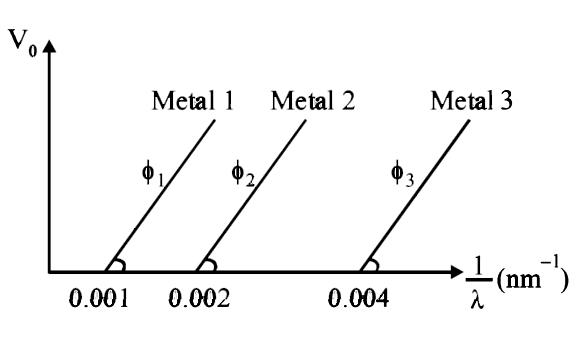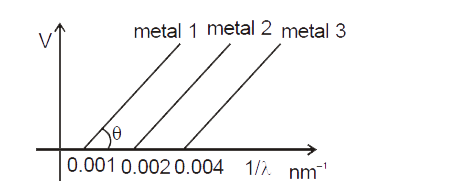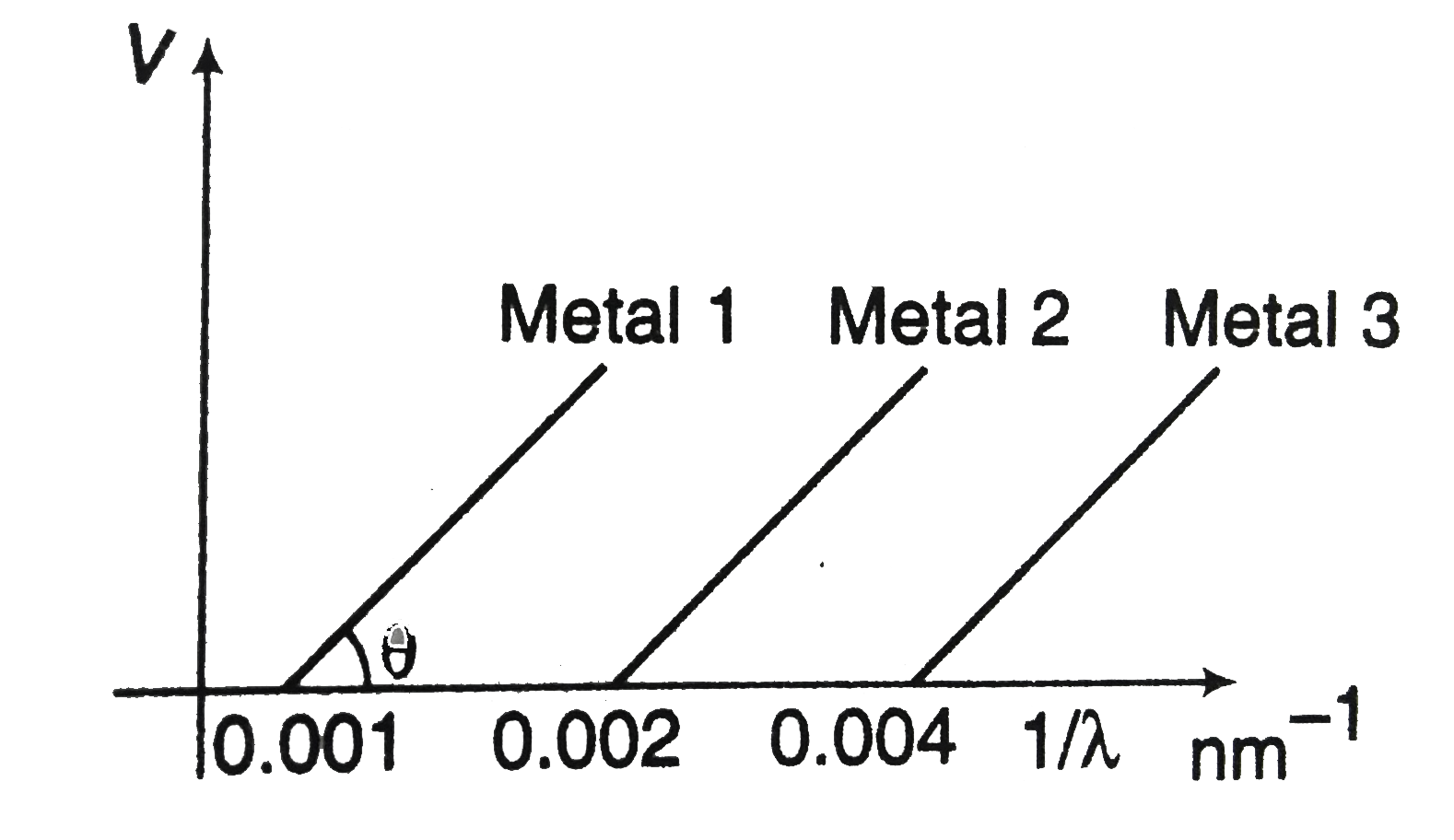The graph between the stopping potential (V0) and (1λ) is shown in the figure ϕ1 , ϕ2 and ϕ3 are work functions. Which of the following is/are correct?

ϕ1:ϕ2:ϕ3=1:2:4
ϕ1:ϕ2:ϕ3=4:2:1
tan θ directly proportional hce, where h is Planck's constant and c is the speed of light
Ultra violet light can be used to emit photoelectrons from metal 2 and metal 3 only.
The correct Answer is:A, C
(a,c) According to Enstein.s photoelectric equation,
hcλ−ϕ=eV where ϕ work function
or V=hceλ−ϕe or V=(hce)1λ−ϕe
V and (1λ) relation represents a straight line.
∴ Slope of line =hce or tanθ=hce
therfore Option (c) is correct
At V0=0,ϕ1:ϕ2:ϕ3=hcλ01:hcλ02:hcλ03
= (0.001 hc) : (0.002 hc):
(0.004 hc) -1 : 2: 4
∴ Option (a) is correct Option (b) is obviously incorrect when (a) is correct.
From graph
1λ01=0.001nm−1∴λ01=1000nm for metal 1.
1λ02=0.002nm−1∴λ02=500nm for metal 2
1λ03=0.004nm−1∴λ03=250nm for metal 3. λ of ultraviolet <400 m
The ultraviolet light can be used to emit photoelectrons from metal 1 and metal 2. It cannot electrons from metal 3.
Option (d) is incorrect.
Option (a) and (c) are correct.

Topper's Solved these Questions
- PARTICLE NATURE OF LIGHT AND WAVE PARTICLE DUALISMBOOK - MTG-WBJEECHAPTER - PARTICLE NATURE OF LIGHT AND WAVE PARTICLE DUALISMEXERCISE - WB JEE PREVIOUS YEARS QUESTIONS
15 Videos
- OSCILLATIONS AND WAVESBOOK - MTG-WBJEECHAPTER - OSCILLATIONS AND WAVESEXERCISE - WB JEE PREVIOUS YEARS QUESTIONS (CATEGORY 3: ONE OR MORE THAN ONE OPTION CORRECT TYPE (2 MARKS))
2 Videos
- SOLID STATE ELECTRONS BOOK - MTG-WBJEECHAPTER - SOLID STATE ELECTRONS EXERCISE - WB JEE Previous Years Questions (CATEGORY 1 : Single Option Correct Type)
15 Videos
Similar Questions
Knowledge Check
The graph between the stopping potential (V0)and(1λ) is shown in the figure ϕ1,ϕ2andϕ3 are work function , which of the following is //are correct
 Aϕ1:ϕ2:ϕ3=1:2:4Bϕ1:ϕ2:ϕ3=4:2:1Ctanθ∝hc€Dultravioletight can be used emit photoelectrons from metal 2 and 3only
Aϕ1:ϕ2:ϕ3=1:2:4Bϕ1:ϕ2:ϕ3=4:2:1Ctanθ∝hc€Dultravioletight can be used emit photoelectrons from metal 2 and 3onlyConsider the following statements
I. ϕ∈{ϕ} II. {ϕ}⊆ϕ Which of the statements given above is/are Correct?AA. I onlyBB. II onlyCC. Both I and IIDD. Neither I nor II
The graph between 1/λ and stopping potential ( V ) of three metals having work functions ϕ1,ϕ2 and ϕ3 in an experiment of photoelectric effect is plotted as shwon in the figure. Which of the following statement (s) is / are correct ? [Here λ is the wavelength of incident ray ].

View SolutionThe graph between 1/λ and stopping potential (V) of three metals having work- functions Φ1, Φ2 and Φ3 in an experiment of photoelectric effect is plotted as shown in the figure. Which of the following statement(s) is/are correct? (Here, λ is the wavelength of the incident ray).

View SolutionThe graph between 1/λ and stopping potential (V) of three metals having work- functions Φ1, Φ2 and Φ3 in an experiment of photoelectric effect is plotted as shown in the figure. Which of the following statement(s) is/are correct? (Here, λ is the wavelength of the incident ray). (a) Ratio of work functions ϕ1:ϕ2:ϕ3=1:2:4 (b) Ratio of work functions ϕ1:ϕ2:ϕ3=4:2:1 (c ) tan θ is directly proportional to hc / e, where h is Planck constant and c is the speed of light (d) The violet colour light can eject photoelectrons from metals 2 and 3 .

View SolutionThe graph between 1λ and stopping potential V0 of two metals having work funcation ϕ1 and ϕ2 in an experiment of photoelectric effect is obtained as shown in the figure. Find out -
_E01_164_Q01.png)
(i) Threshold wavelength ofboth metals
(ii) ϕ1:ϕ2
(iii) Whihc metal cen emit photoelectrons with visible light ?
View SolutionThe graph between 1λ and stopping potential V0 of two metals having work funcation ϕ1 and ϕ2 in an experiment of photoelectric effect is obtained as shown in the figure. Find out -
_E01_164_Q01.png)
(i) Threshold wavelength ofboth metals
(ii) ϕ1:ϕ2
(iii) Whihc metal cen emit photoelectrons with visible light ?
View SolutionLet A={ϕ{ϕ},1,{1,ϕ},2}. Determine which of the following is true or fase.
View Solution
